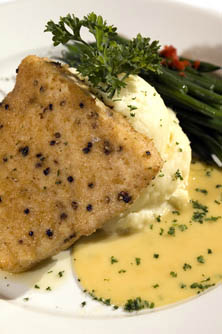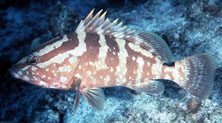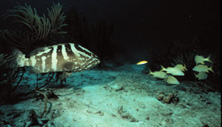Nassau Grouper (Epinephelus striatus)
- Nassau grouper is overfished and overfishing is occurring in the Caribbean. In waters off the continental U.S., population levels are thought to be low, having shown little response to a fishing moratorium established in 1992.
- The Caribbean, South Atlantic, and Gulf of Mexico Fishery Management Councils and the State of Florida prohibit fishing for and possession of Nassau grouper.
- Grouper is low in saturated fat. It is also a good source of vitamins B6 and B12, phosphorus, and potassium, and a very good source of protein and selenium. For more on nutrition, see Nutrition Facts. (USDA)
- Nassau grouper was once one of the most common and important commercial groupers in the insular tropical western Atlantic and Caribbean, but overfishing has reduced their numbers such that they are now protected from fishing in State and Federal waters of the U.S. and are on the International Union for Conservation of Nature's Red List of endangered species.
|
 |
 |
 |
 |
| Nutrition Facts |
| Servings 1 |
| Serving Weight
100g |
 |
| Amount Per Serving |
 |
| Calories 92 |
 |
| Total Fat |
1.02 g |
 |
| Total Saturated Fatty Acids |
0.233 g |
 |
| Carbohydrate |
0 g |
| Sugars |
0 g |
| Total Dietary
Fiber |
0 g |
 |
| Cholesterol |
37 mg |
 |
| Selenium |
36.5 mcg |
 |
| Sodium |
53 mg |
 |
| Protein |
19.38 g |
 |
|
 |
 A Nassau grouper with a surgically implanted telemetry tag and an external tag prior to its release. Through tagging fish that are captured in the fishery and ultrasonic telemetry, NOAA researches have found that Nassau grouper may migrate over 100 miles to spawning aggregations, and may spend only a few days at these aggregations. A Nassau grouper with a surgically implanted telemetry tag and an external tag prior to its release. Through tagging fish that are captured in the fishery and ultrasonic telemetry, NOAA researches have found that Nassau grouper may migrate over 100 miles to spawning aggregations, and may spend only a few days at these aggregations.
|
 |
Did you know?
Nassau grouper are often found near caves or large overhangs.
Long-lived, slow-growing fishes like Nassau grouper are extremely susceptible to overfishing.
Nassau grouper aggregate at specific times and locations to spawn. Fishermen often know where and when these spawning aggregations occur and take advantage of the ability to harvest a large amount of grouper. Entire regional stocks have been wiped out due to this intense fishing pressure on spawning aggregations. Stocks may take several decades to recover from such intense exploitation, and it is unclear whether, once decimated, these spawning aggregations will reform.
|
|
| |
 |
|
Nassau grouper's genus name comes from the Greek Epinephelus meaning clouded over, referring to the membrane that covers the eye of the mottled grouper, while striatus is Latin, referring to Nassau grouper's striped color pattern.
|
 |
|
A Nassau grouper eyeing its next meal. Nassau grouper are ambush suction foragers - they lie and wait for prey and then engulf the organism in a current of water by opening their mouth and quickly expanding their gill covers.
|
|
Sustainability Status
Biomass: Not available
Overfishing: No (S. Atl. and Gulf); Yes (Caribbean)
Overfished: Undefined (Gulf); Unknown (S. Atl.); Yes (Caribbean)
Fishing and habitat: Fisheries for Nassau grouper are closed in the U.S. state and federal waters.
Bycatch: Fisheries for Nassau grouper are closed in the U.S. state and federal waters.
Aquaculture: Nassau grouper is considered a prime species for aquaculture because it is a popular and valuable food fish and stocks are severely depleted. While a lot of progress has been made in hatchery spawning and rearing of groupers under aquarium conditions, the potential of Nassau grouper aquaculture has yet to be determined.
|
Science and Management
The Nassau grouper fisheries are closed in state and federal waters in the South Atlantic and Gulf of Mexico and in territorial and federal waters of Puerto Rico and the U.S. Virgin Islands. Nassau grouper is managed through the Fishery Management Plan (FMP) for the Snapper-Grouper Fishery of the South Atlantic Region, the Gulf of Mexico Reef Fish FMP, and the Caribbean Reef Fish FMP as part of Grouper Unit 1.
|
Life History and Habitat
Life history, including information on the habitat, growth, feeding, and reproduction of a species, is important because it affects how a fishery is managed.
- Geographic range: Throughout the tropical western Atlantic, including waters off Bermuda and Florida throughout the Bahamas and Caribbean Sea, down to Southern Brazil. It also occurs off the Yucatan Peninsula, Mexico but is rare in the Gulf of Mexico.
- Habitat: Nassau grouper live inshore and up to depths of about 330 feet. Adults are found near shallow high-relief coral reefs and rocky bottoms. Juveniles are found in and around coral clumps covered with macroalgae and over seagrass beds.
- Life span: Fairly long-lived, up to 29 years.
- Food: Nassau grouper mostly eat fishes, crabs, and lobsters.
- Growth rate: Slow
- Maximum size: About 39 inches and 55 pounds.
- Reaches reproductive maturity: Late - between 4 and 7 years of age.
- Reproduction: Unlike most groupers, Nassau grouper are primarily gonochronistic (have separate sexes); however, some protogynous hermaphrodites (females that change sex to males) may exist. Nassau grouper assemble in large groups of a few dozen to 100,000 to spawn, most likely cued by temperature and moon phase.
- Spawning season: During winter in lower latitudes and summer in more northerly latitudes (i.e., Bermuda and Florida).
- Spawning grounds: Nassau grouper are well known for forming spawning aggregations throughout their range, generally at the edge of insular platforms, close to a drop-off into deep water over a wide depth range (20-160 feet) and diversity of substrate types. Many of these spawning aggregations have been fished heavily and no longer form.
- Migrations: Nassau grouper may migrate over 100 miles to spawn.
- Predators: Predators include large fish such as barracuda, king mackerel, moray eels, and other groupers. Sandbar shark and great hammerhead shark are also known to feed on groupers.
- Commercial or recreational interest: Both
- Distinguishing characteristics: Nassau grouper have a pale tan or gray body with five dark brown vertical bars, black dots around the eye, a large black saddle-blotch on the caudal peduncle (the narrow part of the fish's body to which the tail fin is attached), and a wide "tuning-fork" pattern on their forehead. They can greatly lighten or darken this overall pattern within minutes. (Nassau groupers exhibit four color phases when spawning - normal striped, white belly, dark, and bicolored - and also change color when they are interacting.)
|
Role in the Ecosystem
Nassau grouper is an important top-level predator on coral reefs. Their diet mainly consists of fishes and crabs. Since Nassau grouper used to be quite abundant in some areas, its decline could impact the reef community.
|
Additional Information
Market name: Grouper
Vernacular names: Hamlet, Cherna Criolla, Rockfish, Merou Rayé, Mero Cherna, Mero Gallina, Mero Batata
|
Biomass
Biomass refers to the amount of Nassau grouper in the ocean. Scientists cannot collect and weigh every single fish to determine biomass, so they use models to estimate it instead. These biomass estimates can help determine if a stock is being fished too heavily or if it may be able to tolerate more fishing pressure. Managers can then make appropriate changes in the regulations of the fishery.
Although Nassau grouper are abundant in the Bahamas, the Caribbean population is considered overfished by NOAA's National Marine Fisheries Service. The South Atlantic population's status is considered unknown and the Gulf is undefined. High levels of fishing throughout the 20th century led to the commercial extinction of the species in the U.S. Caribbean by the mid-1980s. Florida populations declined between the 1950s and reached very low levels in the early 1990s. The status of Nassau grouper has not changed much since the ban on fishing for them in Caribbean and Atlantic waters was implemented, most likely due to illegal fishing practices.
Landings
 Landings refer to the amount of catch that is brought to land. Both commercial and recreational catches of Nassau grouper declined throughout their range since 1980. In many areas, up to 90% of annual commercial landings came from spawning aggregations. Aggregations that were once productive no longer form at traditional sites, such as in Puerto Rico and the U.S. Virgin Islands, and as a result, catches declined sharply. The Caribbean (1990), South Atlantic (1991), and Gulf of Mexico (1996) Fishery Management Councils and the State of Florida (1993) now prohibit take and possession of Nassau grouper. Landings refer to the amount of catch that is brought to land. Both commercial and recreational catches of Nassau grouper declined throughout their range since 1980. In many areas, up to 90% of annual commercial landings came from spawning aggregations. Aggregations that were once productive no longer form at traditional sites, such as in Puerto Rico and the U.S. Virgin Islands, and as a result, catches declined sharply. The Caribbean (1990), South Atlantic (1991), and Gulf of Mexico (1996) Fishery Management Councils and the State of Florida (1993) now prohibit take and possession of Nassau grouper.
Note: The landings shown in the graph only include commercial landings from waters off the continental United States.
Biomass and Landings
Are landings and biomass related? Landings are dependent on biomass, management measures in the fishery, and fishing effort.
Data sources:
Landings from NOAA's National Marine Fisheries Service Annual Commercial Landings Statistics using "GROUPER, NASSAU" as Species and "ALL STATES" as State
|
Important Dates
1950s – Nassau grouper abundance is high in southern Florida; spearfishermen note large daily catches of the species
1970 – Nassau grouper is the fourth most common shallow-water species landed in Puerto Rico; also dominates the reef fish fishery of the Virgin Islands
1975 – Nassau grouper begins declining in western Atlantic (around Bermuda)
1979-1994 – Nassau grouper declines in southern Florida
1981 – Nassau grouper almost completely disappears from catches in the U.S. Caribbean
1983 – South Atlantic Snapper Grouper FMP implemented, establishing a minimum size limit for Nassau grouper and additional harvest and gear limitations
1984 – Gulf of Mexico Reef Fish FMP implemented
1985 – Management measures go into effect in the U.S. Caribbean
1986 – Nassau grouper is considered commercially extinct in the U.S. Virgin Islands/Puerto Rico region
1990 – Capture of Nassau rare in U.S. Caribbean waters, indicating severe overfishing; Caribbean Fishery Management Council prohibits any take or possession of Nassau grouper
1990 – Amendment 1 to the Gulf Reef Fish FMP sets a 20 inch total length minimum size limit on Nassau grouper, a 9.2 million pound quota for shallow-water groupers (including Nassau)
Early 1990s – Nassau grouper is named as a candidate for the U.S. Endangered Species List
1991 – Nassau grouper identified as a species of concern (those species about which NOAA's National Marine Fisheries Service has concerns regarding status and threats, but for which insufficient information is available to indicate a need to list the species under the Endangered Species Act)
1991 – South Atlantic Fishery Management Council decides that Nassau grouper is severely overfished and prohibits all retention of the species
1994 – Only one Nassau grouper is recorded in Dry Tortugas, where Nassaus were once abundant
1996 – Gulf of Mexico Fishery Management Council prohibits the harvest or possession of Nassau grouper in the Gulf EEZ, consistent with similar provisions already in place in Florida state waters, the South Atlantic EEZ, and the Caribbean EEZ
1996 – Nassau grouper appears on the Red List of the International Union for the Conservation of Nature (IUCN)
|
Notes and Links
General Information:
NOAA's National Marine Fisheries Service Office of Protected Resources - Species of Concern Fact Sheet for Nassau Grouper
NOAA's Undersea Research Program Contributes to Nassau Grouper Conservation in the Bahamas
South Atlantic Fishery Management Council Fish ID for Nassau grouper
NOAA's Office of Undersea Research - Studying Nassau grouper spawning aggregations
NOAA Technical Report - Synopsis of Biological Data on the Nassau Grouper, Epinephelus striatus, and the Jewfish, E. itajara
Fishery Management:
Fishery Management Plan (FMP) for the Snapper Grouper Fishery of the South Atlantic Region
Gulf of Mexico Reef Fish FMP
FMP for the Shallow Water Reef Fish Fishery of Puerto Rico and the U.S. Virgin Islands
Stock Assessments:
|
| |
|



